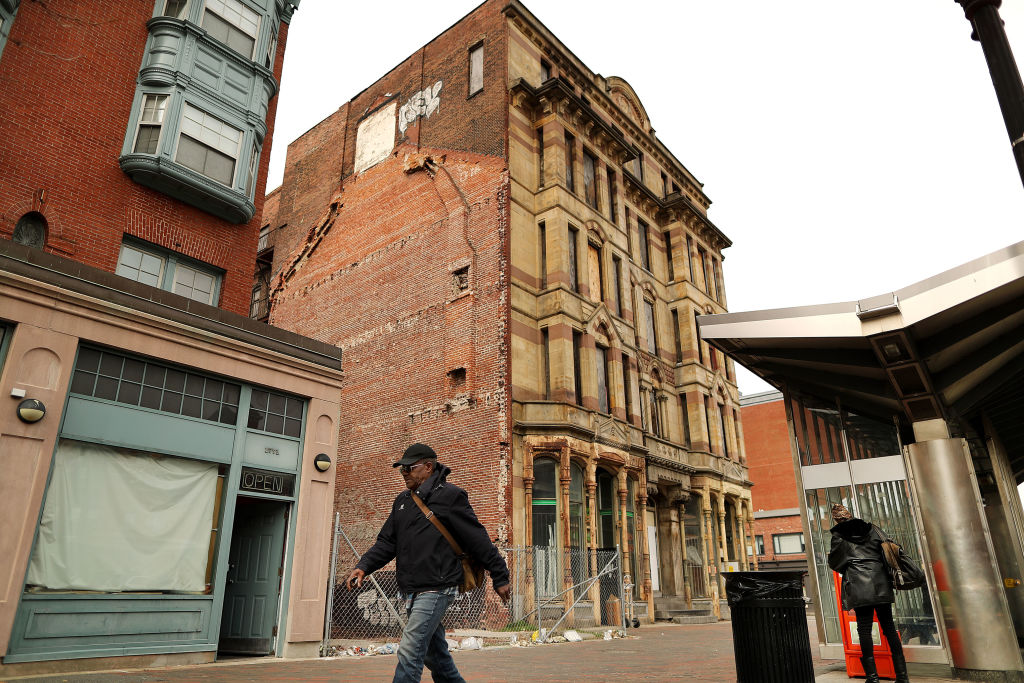While rising inflation and economic uncertainty are worrying people across the country, the social crisis that engulfs large swaths of the American population continues unabated. Drug overdose deaths climbed 15 percent in 2021, topping 100,000 for the first time. After a modest decline during COVID, suicide deaths once again continued their two-decade long trajectory upward, with girls 10 to 14 and young men 15 to 24 seeing the biggest spikes. New data from the Census Bureau shows that people are spending more time than ever alone.
These problems are symptoms of America’s social breakdown—the fraying of the relationships that used to bind us to each other. Strong social relationships foster greater individual well-being, as has been well documented in research on health and happiness. Those relationships do not exist autonomously but are embedded in social structures—marriages, families, networks, schools, and places of worship that exist in our local neighborhoods. When the social structures that support these relationships weaken, the talented and well-off can compensate and move on, but most of us are left more fragile by the strain.
Most American government bodies, philanthropists, and social entrepreneurs don’t view social breakdown through this neighborhood lens. They focus on delivering specific services to meet specific needs—better housing, youth mentoring, or access to better health care—at the level of the individual, ignoring the social aspect of the problem. There is little attempt to bolster—or even engage with—the underlying social fabric in the particular places we live.
How might understanding place-based dynamics help us address social breakdown?
As described in a forthcoming paper for the Mercatus Center at George Mason University, the neighborhood is key. Neighborhoods have a direct and continuous effect on our formation, well-being, and capacities. This is especially true for those in their formative years. Life trajectories can be launched or limited by the nature of relationships children experience at home, on their street, and in their school. Only in-person relationships—not virtual substitutes—offer the support and guidance that kids need. While broader factors such as the economy and government are important, neighborhoods are the one place where you can clearly assess the social dynamics affecting families and individuals and address them in ways that will have long-lasting results.
While many factors influence neighborhood dynamics, the wealth of “organizational life”—the various formal and informal institutions and neighborhood activities that bring people together—is especially important. This enables the informal social control and shared expectations that make up collective efficacy. Much of organizational life is unofficial, such as neighborhood watch groups, residential associations, and weekly children’s activities. But these wither if there are fewer mechanisms to bring people together.
Where once we were a nation of strong neighborhood-based communities, today America is a sprawling land full of houses and apartments that are mostly isolated from one another. More than nine-tenths of the country’s 174,186 block group neighborhoods (clusters of blocks within the same census tract) are not walkable. More than half of rural counties have experienced population declines.
Maps provide labels where once memories provided meaning. Institutions that once brought people together to start families, pray, cooperate to solve problems, or simply to share time with one another have weakened or disappeared. Churches are closing at an alarming rate—with perhaps as many as 100,000 predicted to close over the next decade. Service organizations, which not only bring people together but often do work in their communities, have long struggled to maintain memberships. And the mighty national cross-class voluntary federations that once dominated American life—organizations such as the Knights of Columbus, Veterans of Foreign Wars, and Ancient and Accepted Free Masons—have withered.
All of that leaves fewer community leaders ready to step in when someone has a problem, fewer mentors for couples and children who need them, and fewer institutions that can organize residents to tackle common challenges. The growing concentration of poverty in distressed neighborhoods means that millions of Americans live in places where there are few good examples of successful marriages, careers, and civic engagement. Neighborhood effects explain why many of our society’s problems seem intractable. Without strong neighborhoods, school systems cannot improve educational results, housing authorities cannot increase affordable housing, health care agencies cannot improve health outcomes, and police cannot ensure streets are safe.
As David Edwards, who currently works as an adviser to the mayor of Atlanta, writes “Healthy neighborhoods produce healthy outcomes, because they contain the conditions out of which those outcomes can emerge independently.” What would it take to restore the health of our neighborhoods? Here are a few practicable ideas—and some people trying them.
As a start, civic leaders, policymakers, philanthropists, and social leaders should be re-envisioning the social landscape around clearly demarcated neighborhoods, with a renewed emphasis on in-person exchange and the development of the wealth of “organizational life.” This means taking steps to ensure that residents in each area have a sense of collective identity and mutual responsibility, if not a shared feeling of common community (a much higher bar). Ensuring each neighborhood has its own primary school, a commercial center that can provide everyday facilities and services, and physical assets and institutions that promote bonding and bridging relationships would help.
Decentralizing government such that it served and was responsible to specific neighborhoods would allow local authorities more scope for creativity and local residents more say in how funds are spent. Public servants would know social contexts better and have the opportunity to take more risks—especially if they were committed to a particular geography for an extended period of time and evaluated on the performance of a place rather than the number of permits issued or housing units built. While the United States has an astounding 87,000 different units of government, in which more than 500,000 officials serve, often voluntarily, few if any cover urban neighborhoods.
Governments, philanthropists, and businesses should develop small grant programs to incentivize neighbors to cooperate to improve their blocks, neighborhood leaders to oversee local efforts at change, and nonprofits to invest in programs aimed at strengthening the institutions and activities that embed relationships place by place. The goal would be to foster closer cooperation among residents, build more confidence in a neighborhood, and develop the relationships, institutions, and norms that can transform it over time. The Oswego Renaissance Association has created significant momentum for positive change (and achieved huge returns on investment) in Oswego, New York, by simply offering matching grants of up to $1,000 per home as well as additional resources to blocks of individuals who want to cooperate to improve the look of their streets.
Greater investment in leadership development at the neighborhood level would bolster these initiatives. Universities could, for example, train a future generation of local leaders and social entrepreneurs, giving them credit for time spent working or volunteering in the neighborhoods most in need.
Public and civic leaders should place a far greater emphasis on the development of “third places”—the churches, coffee shops, gyms, hair salons, bars, bookstores, parks, and community centers that host regular, informal gatherings of residents—neighborhood by neighborhood. Whereas we all once lived near such places, many residential areas today purposely exclude them by how they are designed and zoned. Ray Oldenburg, who popularized the concept, writes, “A habitat that discourages association, one in which people withdraw to privacy as turtles into their shells, denies community and leaves people lonely in the midst of many.”
Bolstering social ties across neighborhoods by either boosting transport links, establishing new cross-class institutions, or physically blending two different places would go far in reducing the disadvantage that harms those in our most distressed locales. As Washington, D.C.’s director of planning, Harriet Tregoning developed the original vision that has now become 11th Street Bridge Park. When it opens in 2025, it will connect the district’s poorest ward to one of its wealthiest. Tregoning says, “Lots of people have ideas. That’s not the hard part. The hard part is getting something as wonderful and complicated and difficult as this to happen.”
What does it take to make something happen? As an example, housing departments can reorient toward neighborhood development rather than a siloed mission of building low-income housing units. Education authorities can empower community leaders to improve schools that aren’t delivering by restructuring school catchment areas (places where students are eligible to attend school) and governance structures so as to bolster parent and neighborhood involvement. And various public and private organizations can cooperate to advance a common vision of neighborhood change instead of working at cross-purposes on goals that have little to do with the well-being of a place.
This shift met with success in Atlanta, where various government and private organizations partnered with East Lake Foundation, which was established as a neighborhood quarterback in 1995 to help transform one of the city’s most distressed neighborhoods. It developed high-quality mixed-income housing, established a charter school, built a robust cradle-to college pipeline, and supported the establishment of a mix of community organizations and commercial entities. While every place is different, in general, a neighborhood-based approach means in practice greater openness to mixed-income housing; more collaboration across organizations; more partnerships with the private sector; and more investment in social infrastructure, third places, and the large number of small projects that would incrementally enhance places.
Our country is full of social entrepreneurs, government entities, and civic organizations that do good work—but they often don’t have a sustained impact on the social context in any particular place. Why? Because they are problem or advocacy driven and work over a large area. If we can change how we think about our social challenges, we can unleash the potential of these leaders and organizations in a new way.






Please note that we at The Dispatch hold ourselves, our work, and our commenters to a higher standard than other places on the internet. We welcome comments that foster genuine debate or discussion—including comments critical of us or our work—but responses that include ad hominem attacks on fellow Dispatch members or are intended to stoke fear and anger may be moderated.
With your membership, you only have the ability to comment on The Morning Dispatch articles. Consider upgrading to join the conversation everywhere.